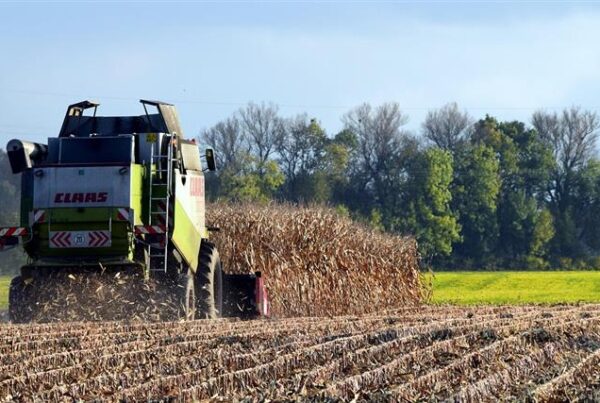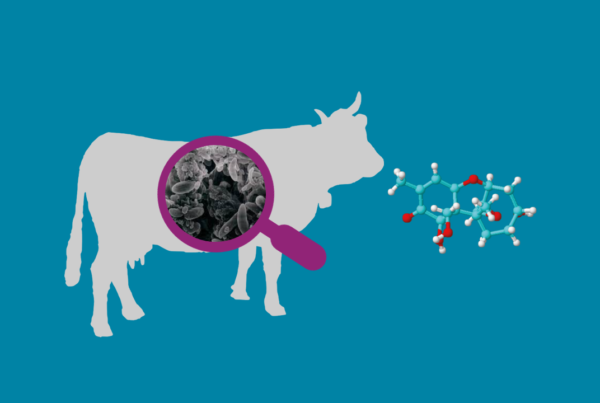Mistral as a key factor to secure successful farm’s sanitation protocols.
Viruses are the smallest and the most complex infectious agents leading to many health challenges in swine. Over the past years, pig production has been challenged by several viral agents causing severe diseases as Porcine Epidemic Diarrhea (PED), Porcine Circoviruses type 2 (PCV2), Swine influenza or Transmissible gastroenteritis (TGE). These challenges directly affect farms economics and broadly the all value-chain economy. Today, concerns are focused on the re-emergence of the African Swine Fever, the most devastating disease against which no vaccine nor effective treatments are yet existing. In this context, prevention is the first line of defense against disease and the only way to manage the outbreak goes through strong sanitation measures.
Better knowing your enemy – virus sensitivity
In order to better adapt the preventative sanitation measures, the knowledge of the viral pathogens is essential. The first classification of viruses is in between DNA viruses and RNA viruses. Secondly, these are classified into families based on their size, shape and structure that can be differentiated into enveloped or naked viruses. According to these characteristics, the survival time of the virus will vary in association with the propagation material (water, faeces, urine, saliva…) and the environmental conditions (temperature, humidity, pH).
Broadly speaking, viruses will longer survive in cold and damp environmenst instead of hot and dry environments. Also, viruses having a fat coating can be inactivated by fat solvents. In the case of ASF, the virus responsible for the disease is a complex and multi-enveloped DNA virus. It’s the sole member of the gene Asfivirus within the Asfarviridae family.
The coating external lipid-containing envelope makes the virus more sensitive to extreme environmental conditions such as strong desiccation or low pH. The disease will be spread by direct contact from a sick to a healthy animal, or by contact of a healthy animal with feed or environment contaminated by the virus. Transmission is also possible through the ticks that ingest the virus by feeding from the blood of infected animals. Hence, taking in consideration all the characteristics of the virus help in building a comprehensive sanitation protocol to avoid the contamination or the spread of the virus.
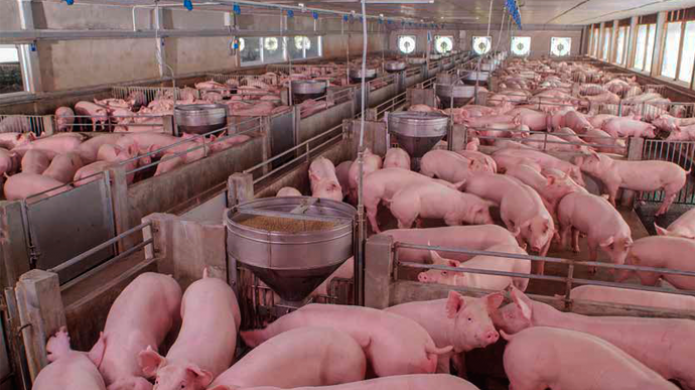
Pig farm.
Sanitation measures
Without vaccines or effective treatments, the only way to prevent viral diseases is to build a very strict and adapted biosecurity plan. Biosecurity brings together all the measures taken to first, prevent the introduction of anew pathogen, also known as external biosecurity or bio-exclusion. Secondly, the measures taken to reduce the spread of viral pathogen already present in the farm environment, also called internal biosecurity or bio-management.
Measures implemented to improve biosecurity can be classified according to three goals: isolation, sanitation and traffic control. Hence, sanitation is at the core of the biosecurity strategy and rely on a rigorous high standard process of cleaning, washing and disinfection, detailed below:
1. CLEANING: A proper cleaning is the starting point of the protocol and an essential step to maximize the disinfection efficacy. The objective is to remove all the organic waste (faeces, bedding, feed residue and dust). This step also includes the removal of all movable materials and equipment (feeders, drinkers, lamps, fan boxes), the isolation of fixed electrics and the water system draining, flushing, cleaning and disinfection.
2. WASHING: The objective of this step is to favor the removal of the remaining organic matter in order to avoid the deactivation of the disinfectant by the organic load. The best way to achieve this step is to first use a high-pressure washer, secondly empty the pits and then apply a detergent. This one will enable to break down the oily biofilm that can protect pathogens from disinfectants, it will also reduce the time needed for washing. Then, pressure wash with hot and clean water around 70ºC or more. According to the literature, the ASF virions can be inactivated at 60°C within 30 min.
3. DISINFECTING: The disinfectant will chemically destroy pathogens remaining on surfaces after a thorough wash. As the action spectra of each disinfectant is different, the objective is to carefully choose the disinfectant according to the viral disease presents in the unit and favor a large spectrum disinfectant. In the case of the ASF enveloped virus, the class of aldehydes disinfectants can be adapted as they have a large spectrum and their mode of action is based on cell wall damage and the inhibition of nucleic acid and protein synthesis.
4. DRYING: Drying is the last but not the least step of the sanitation protocol as it will eliminate the survival pathogens. Indeed, bacteria and viruses can persist in wet conditions. Humidity encourages their multiplication. Hence, the objective is to dry completely and as quickly as possible the surfaces. It’s proven that 5 to 7 days of drying can reduce the pathogen load by 10. As this delay of empty room between two batches is not possible in most farms, the use of a desiccant product to finalize the sanitation process can be very efficient. Regarding the ASF virus, it’s established that this one is sensitive to a strong desiccation.
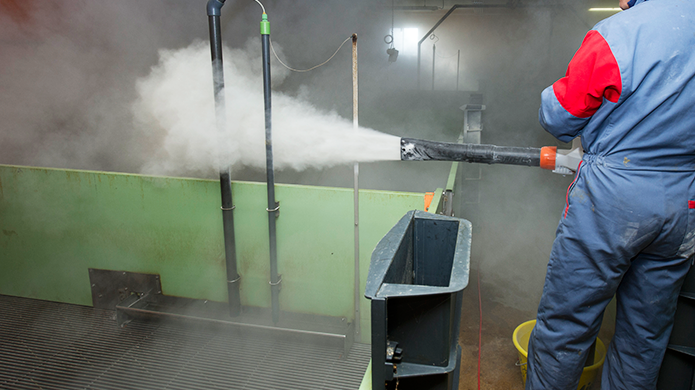
Mistral has proved to be a great asset for environmental hygiene.
Mistral® to secure the sanitation protocol
Used for more than 20 years in swine farms, Mistral® is a natural desiccant product well known for its high drying capacity. The product is made up of a selected clays association, dried and micronized according to a specific grinding process. Thanks to Olmix processing know-how, the layer structure of the clay is preserved, and the size of the particle is extra-fine giving to Mistral® an unrivalled drying capacity in order to reduce the pathogens development in the environment. In addition, the product is enriched with encapsulated essential oils having a repellent action on insects. Hence, as an environmental management tool, Mistral action can be very efficient and at the heart of a biosecurity sanitation protocol. Indeed, the risk of a cleaning and disinfection protocol is the remaining of pathogens in the out of sight and hard to reach spots as fan and ventilation ducts, light fitting or in concrete slates interstices. In this case, blowing Mistral® will enable to homogeneously cover all the surface thanks to the fineness of its particles and reduce the risk of viral pathogens reactivation and development.
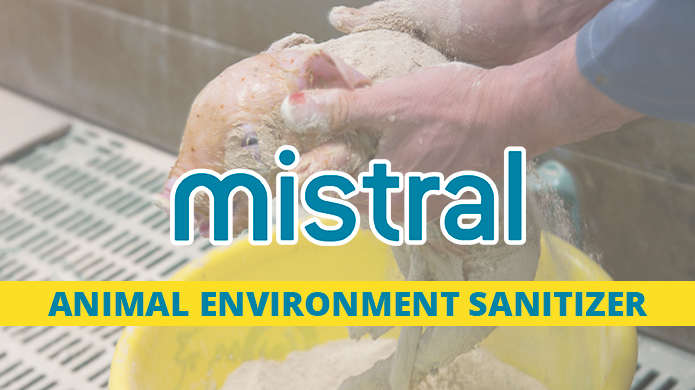
Conclusion
The ASF virus currently occurring in Asia, especially in China and Vietnam has devastating effects on agricultural economies. Without effective vaccine or treatment, prevention through a strict sanitation protocol is the first line of defense against the disease provided well performed and adapted to the viral pathogen.
To finalize and secure the protocol, drying the area with an efficient desiccant product such as Mistral®, supported by 20 years of success in field experience is the key to secure the sanitation of the farm.

